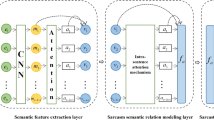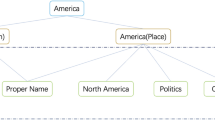Abstract
Sarcasm is a common way of rhetoric in our daily life. It is used to express the opposite of the literal meaning, which makes it a challenging task in sentiment analysis of natural language processing (NLP). The formation mechanism of sarcasm is usually caused by the contrast between the positive sentiment and the negative situation. In this paper, we propose a contextual dual-view attention network (CDVaN) for sarcasm detection according to the formation mechanism of sarcasm. A Contrast Understanding Unit is proposed to effectively extract the contrast between the positive sentiment and the negative situation from the view of formation mechanism of sarcasm. Apart from it, we further use a Context Understanding Unit to extract the contextual semantic information from the contextual semantic view. Our experiments on the IAC-V1 dataset and IAC-V2 dataset demonstrate that the proposed CDVaN model can distinguish sarcasm effectively. The results show that our model achieves state-of-the-art or comparable results.

Similar content being viewed by others
References
Amir S, Wallace BC, Lyu H, Silva PCMJ (2016) Modelling context with user embeddings for sarcasm detection in social media. arXiv preprint arXiv:160700976
Bahdanau D, Cho K, Bengio Y (2014) Neural machine translation by jointly learning to align and translate. arXiv: Computation and Language
Bamman D, Smith NA (2015) Contextualized sarcasm detection on twitter. In: Ninth International AAAI Conference on Web and Social Media
Barbieri F, Saggion H, Ronzano F (2014) Modelling sarcasm in twitter, a novel approach pp 50–58
Bharti SK, Babu KS, Jena SK (2015) Parsing-based sarcasm sentiment recognition in twitter data. In: Proceedings of the 2015 IEEE/ACM International Conference on Advances in Social Networks Analysis and Mining 2015, ACM, pp 1373–1380
Cai Y, Cai H, Wan X (2019) Multi-modal sarcasm detection in twitter with hierarchical fusion model pp 2506–2515
Castro S, Hazarika D, Pérez-Rosas V, Zimmermann R, Mihalcea R, Poria S (2019) Towards multimodal sarcasm detection (an\_obviously\_ perfect paper)
Farías DIH, Patti V, Rosso P (2016) Irony detection in twitter: the role of affective content. ACM Trans Internet Technol (TOIT) 16(3):19
Ghosh A, Veale T (2016) Fracking sarcasm using neural network. In: Proceedings of the 7th workshop on computational approaches to subjectivity, sentiment and social media analysis, pp 161–169
Ghosh A, Veale T (2017) Magnets for sarcasm: making sarcasm detection timely, contextual and very personal. In: Proceedings of the 2017 Conference on Empirical Methods in Natural Language Processing, pp 482–491
Gibbs RW (2000) Irony in talk among friends. Metaphor Symbol 15(1–2):5–27
Gonzalezibanez R, Muresan S, Wacholder N (2011) Identifying sarcasm in twitter: a closer look pp 581–586
Graves A, Jaitly N, Mohamed A (2013) Hybrid speech recognition with deep bidirectional lstm. In: 2013 IEEE workshop on automatic speech recognition and understanding, IEEE, pp 273–278
Hazarika D, Poria S, Gorantla S, Cambria E, Zimmermann R, Mihalcea R (2018) Cascade: contextual sarcasm detection in online discussion forums. arXiv preprint arXiv:180506413
Hochreiter S, Schmidhuber J (1997) Long short-term memory. Neural Comput 9(8):1735–1780
Joshi A, Bhattacharyya P, Carman MJ (2017) Automatic sarcasm detection: a survey. ACM Comput Surveys (CSUR) 50(5):73
Joshi A, Sharma V, Bhattacharyya P (2015) Harnessing context incongruity for sarcasm detection. In: Proceedings of the 53rd Annual Meeting of the Association for Computational Linguistics and the 7th International Joint Conference on Natural Language Processing (Volume 2: Short Papers), vol 2, pp 757–762
Joshi A, Tripathi V, Patel K, Bhattacharyya P, Carman M (2016) Are word embedding-based features useful for sarcasm detection? arXiv preprint arXiv:161000883
Kolchinski YA, Potts C (2018) Representing social media users for sarcasm detection. arXiv preprint arXiv:180808470
Kumar A, Irsoy O, Ondruska P, Iyyer M, Bradbury J, Gulrajani I, Zhong V, Paulus R, Socher R (2015) Ask me anything: Dynamic memory networks for natural language processing. arXiv: Computation and Language
Liebrecht C, Kunneman FA, Den Bosch AV (2013) The perfect solution for detecting sarcasm in tweets #not pp 29–37
Lukin SM, Walker MA (2017) Really? well. Apparently bootstrapping improves the performance of sarcasm and nastiness classifiers for online dialogue. arXiv: Computation and Language
Luong MT, Pham H, Manning CD (2015) Effective approaches to attention-based neural machine translation. Comput Sci. arXiv:1508.04025
Maynard D, Greenwood MA (2014) Who cares about sarcastic tweets? Investigating the impact of sarcasm on sentiment analysis. In: LREC 2014 Proceedings, ELRA
Mishra A, Dey K, Bhattacharyya P (2017a) Learning cognitive features from gaze data for sentiment and sarcasm classification using convolutional neural network. In: Proceedings of the 55th Annual Meeting of the Association for Computational Linguistics (Volume 1: Long Papers), pp 377–387
Mishra A, Kanojia D, Nagar S, Dey K, Bhattacharyya P (2017b) Harnessing cognitive features for sarcasm detection. arXiv preprint arXiv:170105574
Oraby S, Harrison V, Reed L, Hernandez E, Riloff E, Walker M (2017) Creating and characterizing a diverse corpus of sarcasm in dialogue. arXiv preprint arXiv:170905404
Pennington J, Socher R, Manning C (2014) Glove: Global vectors for word representation. In: Proceedings of the 2014 conference on empirical methods in natural language processing (EMNLP), pp 1532–1543
Rajadesingan A, Zafarani R, Liu H (2015) Sarcasm detection on twitter: a behavioral modeling approach. In: Proceedings of the Eighth ACM International Conference on Web Search and Data Mining, ACM, pp 97–106
Ren Y, Ji D, Ren H (2018) Context-augmented convolutional neural networks for twitter sarcasm detection. Neurocomputing 308:1–7
Ren L, Xu B, Lin H, Liu X, Liang Y (2020) Sarcasm detection with sentiment semantics enhanced multi-level memory network. Neurocomputing 401:320–326
Reyes A, Rosso P (2012) Making objective decisions from subjective data: detecting irony in customer reviews. Decision Support Syst 53(4):754–760
Reyes A, Rosso P, Buscaldi D (2012) From humor recognition to irony detection: the figurative language of social media. Data Knowl Eng 74:1–12
Riloff E, Qadir A, Surve P, De Silva L, Gilbert N, Huang R (2013) Sarcasm as contrast between a positive sentiment and negative situation. In: Proceedings of the 2013 Conference on Empirical Methods in Natural Language Processing, pp 704–714
Tang D, Qin B, Liu T (2016) Aspect level sentiment classification with deep memory network pp 214–224
Tay Y, Tuan LA, Hui SC, Su J (2018) Reasoning with sarcasm by reading in-between. arXiv preprint arXiv:180502856
Tran NK, Niedereee C (2018) Multihop attention networks for question answer matching pp 325–334
Tran NK, Niedereée C (2018) Multihop attention networks for question answer matching. pp 325–334, https://doi.org/10.1145/3209978.3210009
Yang Z, Yang D, Dyer C, He X, Smola A, Hovy E (2016) Hierarchical attention networks for document classification. In: Conference of the North American Chapter of the Association for Computational Linguistics: Human Language Technologies
Zhang M, Zhang Y, Fu G (2016) Tweet sarcasm detection using deep neural network. In: Proceedings of COLING 2016, The 26th International Conference on Computational Linguistics: Technical Papers, pp 2449–2460
Acknowledgements
This work is partially supported by grant from the Natural Science Foundation of China (Nos. 62076046, 61632011, 62006034, 61772103), the Fundamental Research Funds for the Central Universities, the Ministry of Education Humanities and Social Science Project (No. 19YJCZH199), the Foundation of State Key Laboratory of Cognitive Intelligence, iFLYTEK, P.R. China (COGOS-20190001, Intelligent Medical Question Answering based on User Profiling and Knowledge Graph).
Author information
Authors and Affiliations
Corresponding authors
Ethics declarations
Conflict of interest
The authors declare that they have no conflict of interest.
Additional information
Publisher's Note
Springer Nature remains neutral with regard to jurisdictional claims in published maps and institutional affiliations.
Rights and permissions
About this article
Cite this article
Ren, L., Lin, H., Xu, B. et al. Learning to capture contrast in sarcasm with contextual dual-view attention network. Int. J. Mach. Learn. & Cyber. 12, 2607–2615 (2021). https://doi.org/10.1007/s13042-021-01344-2
Received:
Accepted:
Published:
Issue Date:
DOI: https://doi.org/10.1007/s13042-021-01344-2




